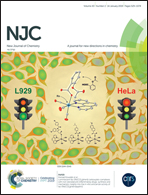Acid–base behaviour and binding to double stranded DNA/RNA of benzo[g]phthalazine-based ligands†
Abstract
The affinity and the binding mode of two benzo[g]phthalazine compounds, functionalized with one or two 2-(imidazole-4-yl)-ethylamine groups, to DNA and RNA models have been evaluated by means of UV-Vis, fluorescence and circular dichroism (CD) spectroscopies in combination with viscometry and molecular dynamics. Both organic molecules bind strongly to all nucleic acid models via the intercalation mode in the duplex structure, especially compound 1. Intriguingly, 1 exhibits different emission responses depending on the base composition of duplex DNA/RNAs, which points out the possibility of using it as a base selective nucleic acid probe. Moreover, the acid–base behaviour of both compounds has been studied by pH-metric titrations and UV-Vis and emission fluorescence techniques to investigate the unexplored basicity of this type of compound. 1 behaves as a triprotic base whilst 2 is a diprotic base with the protonation of the benzo[g]phthalazine moiety occurring in the physiological pH range.
![Graphical abstract: Acid–base behaviour and binding to double stranded DNA/RNA of benzo[g]phthalazine-based ligands](/en/Image/Get?imageInfo.ImageType=GA&imageInfo.ImageIdentifier.ManuscriptID=C8NJ05039B&imageInfo.ImageIdentifier.Year=2019)


 Please wait while we load your content...
Please wait while we load your content...